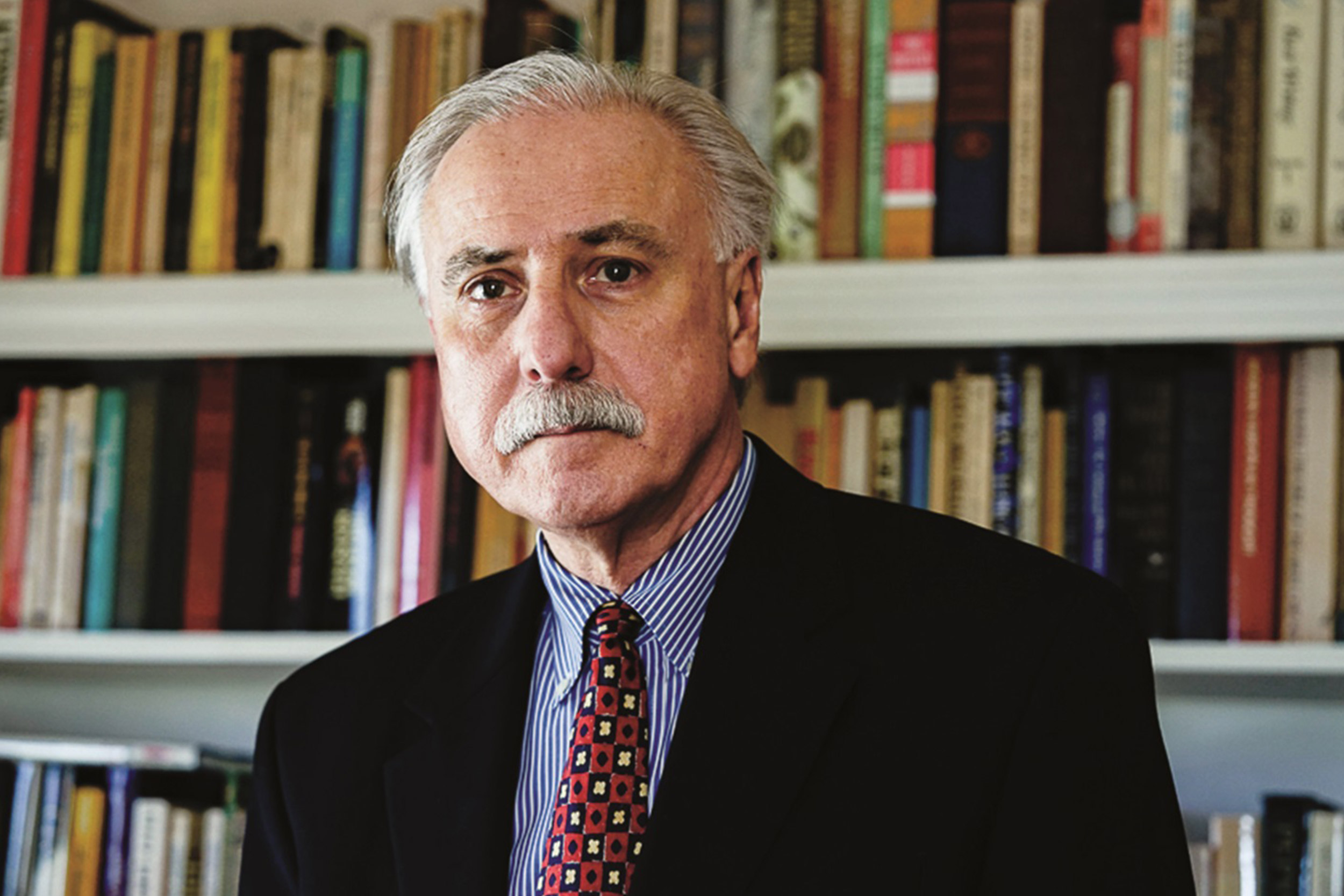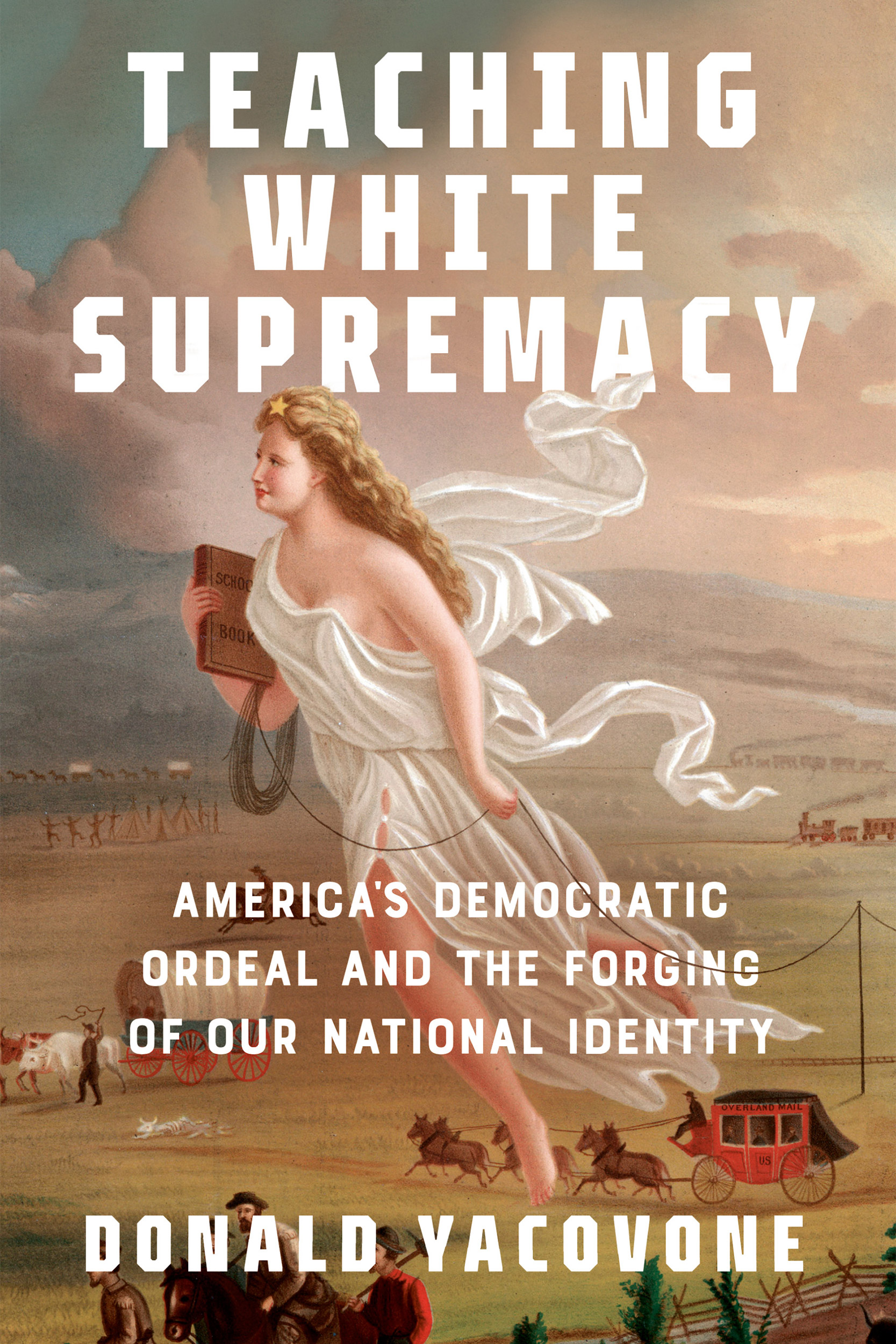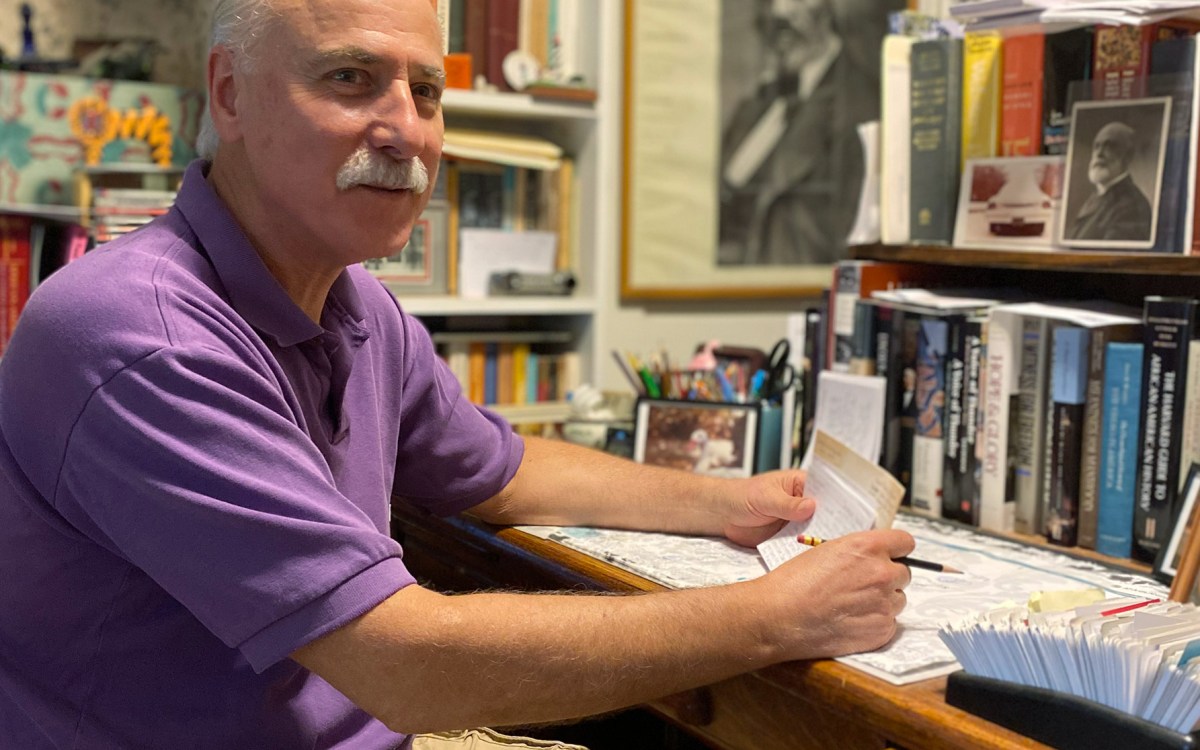
Donald Yacovone is an associate at the Hutchins Center for African & African American Research.
Photo by David Harris
How white supremacy became part of nation’s fabric
Historian Donald Yacovone’s new book chronicles racist values, historical falsehoods woven through generations of school textbooks
Excerpt from “Teaching White Supremacy: America’s Democratic Ordeal and the Forging of Our National Identity” by Donald Yacovone, Associate, Hutchins Center for African & African American Research
Several years ago I began a study of the antislavery movement’s legacy. I focused on the century after 1865 to understand how the “collective” or “popular” memory of the original freedom struggle helped create the modern civil rights movement. As part of this project, I wanted to measure how abolitionism had been presented in our nation’s K–12 school textbooks. I naïvely imagined a quick look at a few volumes and then a speedy return to my primary research. Instead, I found myself overwhelmed by the collection of nearly 3,000 U.S. history textbooks, dating from about 1800 to the 1980s, at the Monroe C. Gutman Library at Harvard University’s Graduate School of Education.
I plunged in and resurfaced with a solid sense of what schoolbooks were like before 1865 — so I could fully grasp the later history of the history I wished to understand. But in a clear inversion of Robert Frost’s “The Gift Outright,” I was the collection’s before the collection was mine. Within a short time, I found myself immersed in a study of how slavery, race, abolitionism, and the Civil War and Reconstruction have been taught in our nation’s K–12 schoolbooks from about 1832 to the present.
One morning as I examined a library cart bursting with about 50 elementary, grammar, and high school history textbooks, a bright red spine reached out to me through time and space. Why is this familiar? I wondered. As I opened the book, it all came rushing back. Somehow I had never forgotten the book’s image of Eli Whitney, included not for his notorious cotton gin but instead for “inventing” the concept of interchangeable parts — thus laying the groundwork for industrialization. “Exploring the New World,” by O. Stuart Hamer, Dwight W. Follett, Benjamin F. Ahlschwede, and Herbert H. Gross — published and reprinted between 1953 and 1965 — had been assigned in my fifth-grade social studies class in Saratoga, Calif.
Just like a legion of the early textbooks I had been reading, “Exploring the New World” never mentioned the antislavery movement. Slaves, on the other hand, proved necessary to pick cotton — “Who else would do the work?” the authors asked. This textbook, and nearly all the texts I reviewed, was not published by a Southern segregationist press, and certainly not by the Klan or other far-right publishers — although such presses emerged with a vengeance in the 1920s and still operate, especially online. No, the thousands of textbooks that have stained the minds of generations of students, from the elementary grades to college, were produced almost entirely by Northern publishing houses, situated mostly in New York, Boston, and Chicago, and by Northern-trained scholars and education specialists.
At the same time, however, my fifth-grade textbook also stated that the people of the North did not believe that men and women “should be bought and sold.” “Exploring the New World,” published during the Cold War, followed the same pattern set at the close of the 19th century, seeking sectional reconciliation regarding issues related to slavery and the Civil War. Its authors also wished to avoid cultural strife (and the reality of slavery and racism) and promoted national unity in the early 1960s by asserting that during the Civil War everyone (white) was brave, everyone (white) fought for principle, and Gen. Robert E. Lee represented all that was noble, gallant, and heroic in American society. “His name is now loved and respected in both North and South,” they explained. “We know that he was not only a gallant Southern hero but a great American.” What we have been teaching our children for nearly all American history suddenly became real, and personal.
The depth, breadth, and durability of American white supremacy and racial prejudice is certainly no revelation to modern historians and social analysts, Black and white. To understand why it has proved so dominant, so irresistibly appealing, even essential, we must survey its development and range. No better place exists to trace that development and cultural importance than in the long history of the nation’s textbooks. Embodying the values to be treasured by rising generations of Americans, textbook authors passed on ideas of white American identity from generation to generation. Writers crafted whiteness as a national inheritance, a way to preserve the social construction of American life and, ironically, its democratic institutions and values. Given the extent of the nation’s belief in white supremacy, one would be astonished if it had not been a guiding principle of our textbooks.
Of course belief in white supremacy and Black inferiority existed long before the creation of the American republic and, along with a sincere — but not contradictory — belief in democratic republicanism, always has occupied the center of the American soul. James Baldwin, the celebrated African American writer and critic, recalled in 1965 that “I was taught in American history books that Africa had no history and that neither had I. I was a savage about whom the least said the better, who had been saved by Europe and who had been brought to America.” After school, he returned home and thought, “Of course, that this was an act of God. You belonged where white people put you.”
And it always had been so.

In the 1920s, for instance, if an African American student had asked a teacher why no Black people appeared in their history textbook, the answer would be that African Americans “had done nothing to merit inclusion.” As the Black scholar Charles H. Wesley reported in 1925, through textbooks and classroom instruction, the Black student quickly realized that “his badge of color in America is a sign of subjugation, inferiority and contempt.” In 1939, the NAACP surveyed popular American history textbooks, and as one Black student concluded from the association’s findings, since textbooks “drilled” white supremacy “into the minds of growing children, I see how hate and disgust is motivated against the American Negro.”
Surveying American history school textbooks from the early 19th century to the present day provides a profound insight into the full depth of the national commitment to white supremacy. It also allows us to trace exactly how white supremacy and Black inferiority have been drilled into student minds generation after generation. In addition this exploration focuses on the responsibility of Northern leaders and educators for the creation and dissemination of white supremacy and construction of the “color line.”
For most of modern American history, scholarship and popular thought have blamed the legacy of Southern slavery for the distressing persistence of racial inequality. And of course, slave owners and their descendants do possess a unique and lethal responsibility for racial suppression. But it is also the case that if no slaves ever existed in the South, Northern white theorists, religious leaders, intellectuals, writers, educators, politicians, and lawyers would have invented a lesser race (which is what happened) to build white democratic solidarity, and in that way make democratic culture and political institutions possible. As one of our greatest authors, Toni Morrison, once explained, in the United States the rights of man were “inevitably yoked to Africanism.” In other words, American democracy depended on Black inequality to sustain white equality.
History textbooks proved a perfect vehicle for the transmission of such ideas, those deemed central to the survival of the nation’s democratic experiment. But their influence would, at first, be slow to develop. While U.S. history textbooks began appearing after 1800, the number began to significantly increase only after the 1820s as New England, New York, and parts of Virginia established publicly supported high schools that mandated the teaching of history. While private elementary and grammar schools and academies existed throughout the country, along with private tutors, publicly supported ones existed mostly in the North, with few in the South, outside portions of Virginia and North Carolina, until after the Civil War.
Most Americans, for much of the nation’s history, simply did not attend any high school or its equivalent. As late as 1930, only about 30 percent of teenagers graduated from a high school, and in 16 Southern and Western states, only 14.2 percent of whites and 4.5 percent of Blacks of high school age attended public schools. The disadvantages heaped on African Americans, in a segregated world, are evident from the fact that in 1900 only 92 Black high schools existed in the country, and 16 years later a total of only 64 had been established for Washington, D.C., and the entire South. Those numbers would only grow, however, and by 1962 about 70 percent of American teens graduated from high school.
But attendance in the lower grades and literacy in general would always be high, catapulting sales of U.S. history textbooks to astounding levels. In 1912 the U.S. Commissioner of Education estimated that annual sales of all textbooks had soared to at least $12 million, about $300 million in modern currency! Just six years later the value had almost doubled. By 1960, 50 U.S. textbook publishers hauled in about $230 million in sales, which leaped to over half a billion dollars by 1967, and by 1975, yearly sales of textbooks surpassed $600 million.
Until recent days, Americans have always emphasized the importance of learning, especially through history. In 1857 Amos Dean, the Vermont-born president of the University of Iowa, explained that history was not philosophy teaching by example but “God teaching by examples.” In history, he maintained, we could see the “record of human progress.” About 30 years later Francis Newton Thorpe, a political scientist from the University of Pennsylvania, advised American schools and colleges that history and economics were the two most important areas of study for American youth, one pertaining to the past, the other to the future. “Together,” he wrote, “they mirror the life of the nation.” Before the end of the century, the influential Johns Hopkins University historian Herbert Baxter Adams argued that history should be taught to all American youth. Rather than an aggregation of “dead facts,” history embodied “the self-conscious development of the human race,” a “living fact,” and “self-knowledge.”
Far from mere aggregations of dead facts, history texts served as reservoirs of values, patriotism, and national ethos. As other studies have shown, from the start history textbooks sought to create unity through storytelling, creating a national identity that could serve as a road map to the future. As the early-20th-century education reformer and peace advocate Fannie Fern Andrews remarked, history existed as “training for citizenship in its broadest sense.” Our “boys and girls must be made to feel … that they themselves are in its very current,” a 1902 textbook explained, and history should foster integrity in the private and public lives of “each individual citizen of the republic.” History explained how democracy came about and offered indispensable assurances during times of national crisis.
In part, we are right to see history textbooks as “prayer-books” of our national civil religion, as “engines of democracy and equality.” But we have been selective in what we cherish in them and blind to what, in time, has proved disconcerting, if not shameful and humiliating. Thomas A. Bailey’s “The American Pageant” became one of the most popular textbooks of the mid-20th century, with at least 13 editions in his lifetime and many more after his death. As he wrote in his autobiography, Bailey had sought to craft a general survey of the nation’s history that would “reveal it as a beacon-light success in democracy.” But behind the animated pages and colorful images lay equally important subtexts that determined what became enshrined as “history” and “democracy.”
Bailey explained that when he wrote his textbook, he focused on “the movers and shakers, not about the stagehands who shifted the scenery or the housewives who cooked the meals of the men who controlled events.” Only because of “public pressure,” he complained, did some textbook authors include “more pictures of prominent black leaders for Negro rights — Frederick Douglass, Booker T. Washington, Martin Luther King, Jr., and others — and to say something favorable about them.” But no such images ever appeared in his book, and he never even mentioned King. “Descendants of slaves,” he said, did not want to be reminded of slavery’s legacy. Astonishingly, such exclusion proved an advancement over what his contemporaries were still writing and what had come before.
Thomas Maitland Marshall’s “American History,” published in 1930, embodied the assumptions and biases that characterized nearly all American history textbooks published before the 1960s. The very first page of his book shrieks: “the story of the white man.” Marshall said very little about the establishment and growth of the institution of slavery but dwelled considerably on what he viewed as “slave character.” Regardless of his situation or condition, he wrote:
“… the negro of plantation days was usually happy. He was fond of the company of others and liked to sing, dance, crack jokes, and laugh; he admired bright colors and was proud to wear a red or orange bandana. … He was never in a hurry, and was always ready to let things go until the morrow. Most of the planters learned not the whip, but loyalty, based upon pride, kindness, and rewards, brought the best returns.”
A group of influential textbook authors and writers repudiated such fantasies of racism and white supremacy immediately after the Civil War, hoping to fulfill an Emancipationist view of the conflict and especially of Reconstruction. Authors like Thomas Wentworth Higginson, a supporter of John Brown and commander of the 1st South Carolina Volunteers during the war, and Charles Carleton Coffin, an abolitionist and the North’s best-known war correspondent, had crafted immensely popular histories of the nation designed for school-age children. But their works always struggled against simultaneously published Northern and Southern history textbooks that repudiated such egalitarian aims, and they largely — though not entirely — waned by century’s end.
At the advent of the 20th century, the overwhelming majority of American textbooks began with Marshall’s assumption that the history of the United States was the history of the white man, his struggles against Native Americans (usually rendered as “red savages”), and his need to control the lives of African Americans. The history of the country was, in part, depicted as their intolerable efforts to challenge, even destroy, “the superior race.” As a 1918 text explained to students, whatever non-English people had done to help create the United States, “the forces that have shaped that life have been English.” The nation had a fixed identity, books asserted, one inherited exclusively from Great Britain.
Additionally, historians who helped shape national character and interpret the past for thousands of students, like the industrialist James Ford Rhodes, who was president of the American Historical Association, relied on the earlier “science” produced by men such as Harvard University’s famed ethnologist Louis Agassiz. For generations, Rhodes and scores of subsequent authors parroted the foul gurgling of Agassiz and others and informed their readers that Blacks were either a separate species or vastly inferior humans, “indolent, playful, sensual, imitative, subservient, good natured, versatile, unsteady in purpose, devoted, and affectionate.” Most textbooks, and certainly those appearing since the beginning of the 20th century, presented Blacks as a foreign, repellent element, an unwanted presence, a necessary evil, or a threat, and always, as one 1914 textbook asserted, “a problem that it took many years to solve.”
The real problem to solve, however, has been the persistence of white supremacy and its enduring and destructive cultural assumptions. Freedom and slavery, democratic ideas and white supremacy, existed long before the nation’s founding. The tensions produced by these competing forces were embedded in the essence of the American republic and, as the prolific and influential historian Ira Berlin wrote, in “the meaning of the American experience.” As early as 1765, the Revolutionary leader James Otis understood that all colonists “are by the law of nature freeborn, as indeed all men are, white or black.” But as modern commentators have observed, despite a ghastly war fought over slavery and more than 150 years of concerted efforts by African American and white activists, “the notion of America as white and Christian has stubbornly refused to dissipate.” The soul of the nation remains white.
Reprinted by permission of Pantheon Books, an imprint of the Knopf Doubleday Publishing Group, a division of Penguin Random House LLC. Copyright © 2022 by Donald Yacovone.





